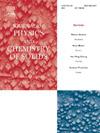先进锂硫电池夹层的空间结构设计
IF 4.3
3区 材料科学
Q2 CHEMISTRY, MULTIDISCIPLINARY
引用次数: 0
摘要
多硫化锂穿梭效应阻碍了锂硫(Li-S)电池的实际应用。解决这一问题的有效方法是利用层间工程来限制多硫化物并促进其催化转化。从空间角度出发,我们设计了一个碳纳米纤维导电层(CNF,不含锡,标记为 0)和两个掺锡碳纳米纤维催化层(SCNF,锡含量分别为 10 wt% 和 20 wt%,标记为 1 和 2),催化剂含量各不相同、并通过调整导电层和催化层与硫阴极之间的优先接触顺序,验证了一种高效的层间结构,从而形成了抑制和转化多硫化锂的分层体系。电化学测量结果表明,不同的空间构型对锂-S 电池的电化学性能有显著差异。因此,210 的空间构型能使锂-S 电池在 0.2C 下循环 100 次后提供高达 1088 mAh g-1 的比容量。即使在高硫负荷(5.6 mg cm-2)和贫电解质(E/S = 10 μL mg-1)的苛刻条件下,锂-S 电池也能在 0.2C 温度下稳定循环 94 次,容量保持率达 87%。这项研究为推进高性能锂-S 电池的空间设计提供了一种新颖的空间策略。本文章由计算机程序翻译,如有差异,请以英文原文为准。
Spatial structure design of interlayer for advanced lithium–sulfur batteries
The practical application of lithium-sulfur (Li–S) batteries has been hindered by the lithium polysulfide shuttle effect. An effective way to solve this problem is to utilize interlayer engineering to confine polysulfides and promote their catalytic conversion. From a spatial perspective, we designed a carbon nanofiber conductive layer (CNF, without Sn content, labeled as 0) and two Sn-doped carbon nanofiber catalytic layers (SCNF, with 10 wt% and 20 wt% Sn content, labeled as 1 and 2, respectively) with different contents of catalyst content, and verified an efficient interlayer structure by adjusting the order of preferential contact between the conductive layer and the catalytic layer with the sulfur cathode to form a hierarchical system for the inhibition and conversion of lithium polysulfide. Electrochemical measurements show that different spatial configurations have significant discrepancies on the electrochemical performance of Li–S batteries. Thus, the space configuration of 210 enables the Li–S battery to provide a specific capacity of up to 1088 mAh g−1 after 100 cycles at 0.2C. Even under the harsh conditions of high sulfur loading (5.6 mg cm−2) and lean electrolyte (E/S = 10 μL mg−1), the Li–S battery was able to cycle stably for 94 cycles at 0.2C with 87 % capacity retention. This study provides a novel spatial strategy for advancing the spatial design of high-performance Li–S batteries.
求助全文
通过发布文献求助,成功后即可免费获取论文全文。
去求助
来源期刊
CiteScore
7.80
自引率
2.50%
发文量
605
审稿时长
40 days
期刊介绍:
The Journal of Physics and Chemistry of Solids is a well-established international medium for publication of archival research in condensed matter and materials sciences. Areas of interest broadly include experimental and theoretical research on electronic, magnetic, spectroscopic and structural properties as well as the statistical mechanics and thermodynamics of materials. The focus is on gaining physical and chemical insight into the properties and potential applications of condensed matter systems.
Within the broad scope of the journal, beyond regular contributions, the editors have identified submissions in the following areas of physics and chemistry of solids to be of special current interest to the journal:
Low-dimensional systems
Exotic states of quantum electron matter including topological phases
Energy conversion and storage
Interfaces, nanoparticles and catalysts.

 求助内容:
求助内容: 应助结果提醒方式:
应助结果提醒方式:


